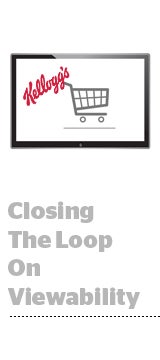Kellogg’s has teamed up with Nielsen Catalina Solutions (NCS), Moat and Yahoo’s BrightRoll to measure how factors in video advertising like “time in view” and “audibility” affect purchases.
For each set of exposures Kellogg’s bought using BrightRoll, Moat provided metrics around player size, time spent and whether the video’s sound was on or off. Nielsen Catalina applies offline sales data to video inventory to determine the ad impact.
Kellogg’s test campaign challenges the assumption that video views automatically create sales impact.
“More stringent in-view minimums, customized to the format of delivery, are required,” said Chris Osner-Hackett, senior director of KNA Media and Experience Planning for Kellogg Co.
For instance, NCS and Moat found that videos in view for seven to 16 seconds contributed more toward sales versus anything more or less than that length, despite the industry standard being two seconds with 50% of pixels in view.
In addition, videos with the sound on had more than double the impact on sales than videos that had the sound off upon the video’s completion.
NCS also noticed nuances in the effect of reach and frequency on sales.
“Reach is particularly important, but not just reach among all people – it’s reach among opportunities to purchase,” said Andrew Feigenson, chief revenue officer for NCS. “I may buy bottled water once a week, you may buy it once a year. So my ability to influence a purchase is largely dependent on how many times you’re going to a store and when I capture you in the purchase cycle.”
He added: “The most interesting thing we discovered is there is no black and white definition in terms of what works with time spent.”
For instance, if a consumer mass ordered bottle water for a year and Nestle Waters shows them an ad, they’re less likely to be influenced by that exposure.
Connecting viewability to sales is a step toward more stringent measurement. Early studies looking at digital-to-offline sales were really expensive and took months or years to complete.
But as more offline data goes online (25% of NCS’ business is now attributed to programmatic transactions), measuring ad effectiveness has become more automated and faster.
This speed enables marketers to run online brand advertising campaigns based on performance.
Even with the Kellogg’s study, onboarding NCS’s offline data wasn’t totally seamless, said Tom Schmidt, VP of ad products for Yahoo. But he predicts the process will soon become easier: “Over time, I think you’ll see those kinds of integrations becoming more API-driven.”














